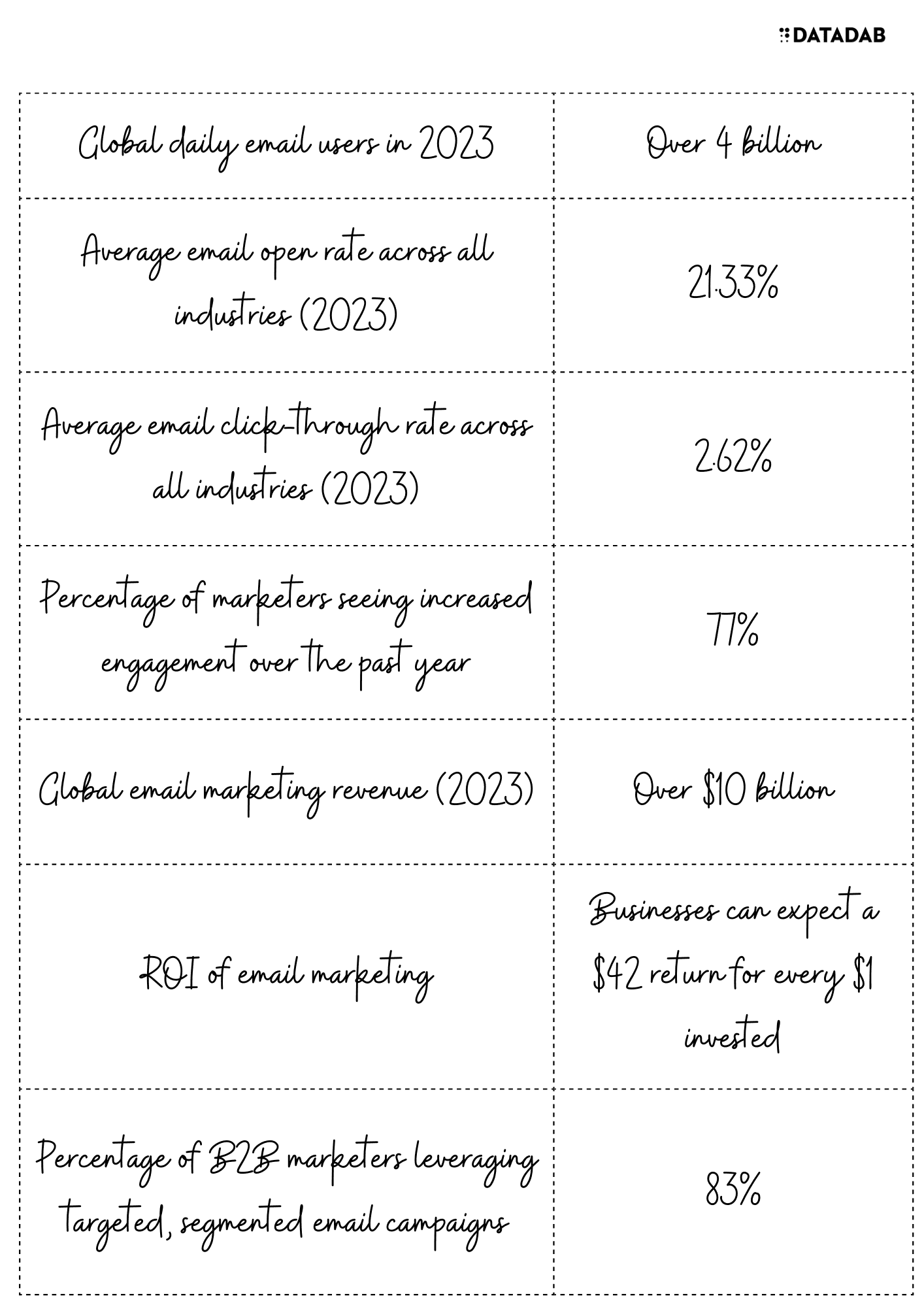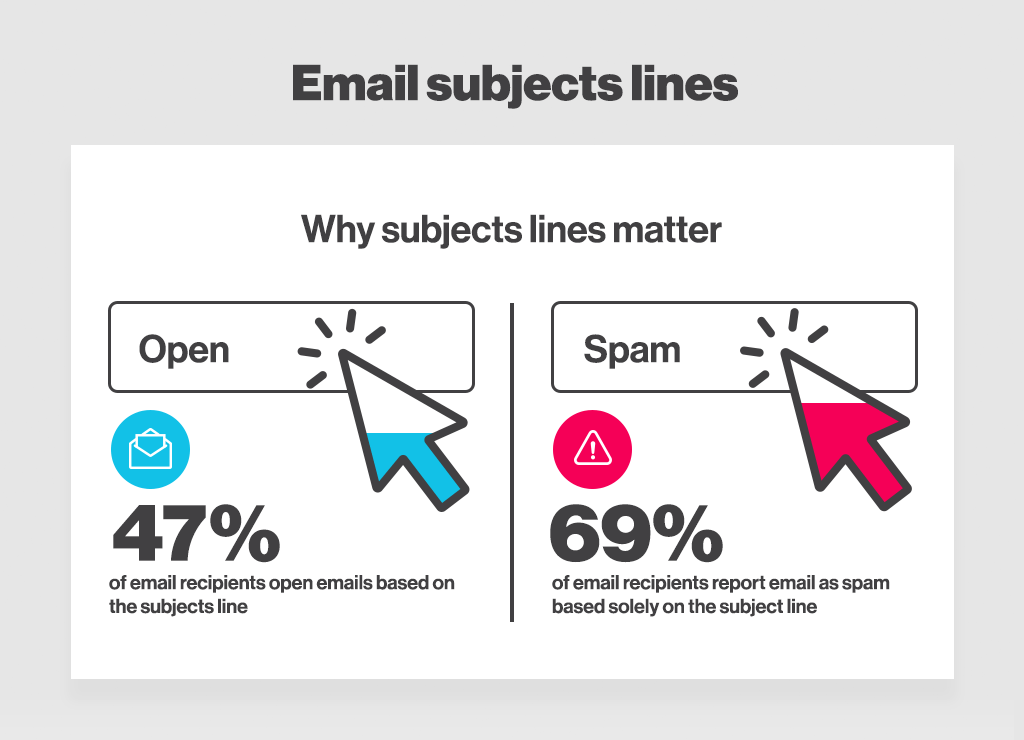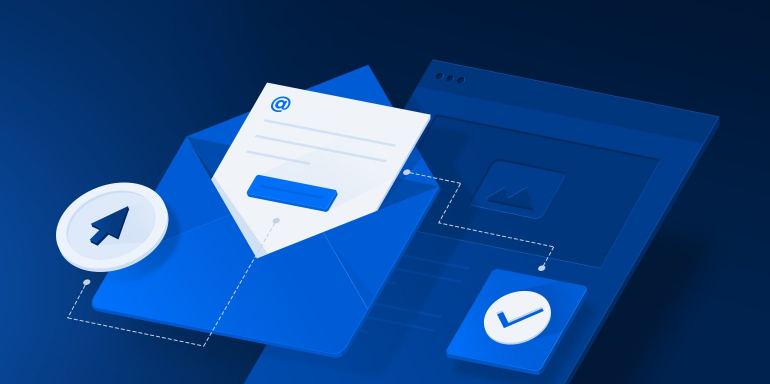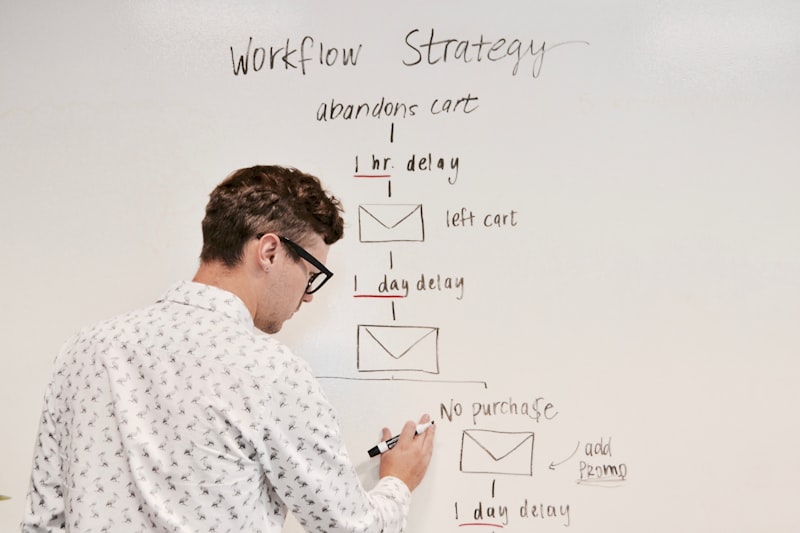I'll admit it: I used to be obsessed with open rates. That tiny percentage was my guiding star… until I realized it was leading me astray. Sure, a catchy subject line might entice someone to open an email, but if the content inside falls flat, what's the point? That's when I knew I needed a shift in perspective.
For every $1 spent on email marketing, the average return is $42.
In this essay, I, as a seasoned SaaS marketing agency owner, aim to share inspirational tales and pragmatic tactics gleaned from the world's top email marketing gurus. Whether you're a novice seeking a solid foundation or an experienced marketer desiring to refine your email strategy, this guide will ignite fresh ideas and illuminate the path toward email marketing excellence.

1. Cultivating Curiosity: The Key to Captivating Subject Lines


A powerful subject line serves as the digital “knock” on your subscriber's inbox door. Email marketing legend Ann Handley emphasizes brevity, clarity, and a hint of intrigue as the core components of a winning subject line. Let's take a leaf out of her book by exploring specific ways to spark curiosity and cultivate 'must-open' subject lines:
The Question Technique: Posing an open-ended question immediately engages the recipient. For instance, a SaaS company specializing in marketing automation might use: “Struggling to convert leads into loyal customers?”
The Power of Specificity: Utilize numbers, percentages, or relevant data points to grab attention. Example: “Increase Email Click-throughs by 25% With This One Trick”
The Scarcity Principle: Evoke a subtle sense of urgency to generate click-worthy subject lines. Example: “Flash Sale: 30% Off Our Productivity Tool (Ends Today)”
It's important to remember that a bit of personalization, like including the recipient's name, can significantly boost open rates. Remember, even an intriguing subject line is only the first step. To win the battle for reader attention, you'll need to deliver on the promise and value hinted at in that initial subject line.
2. Embrace Storytelling: Crafting Enthralling Email Content
Within the body of your email lies an opportunity to tell a compelling story that builds a genuine connection with your readers. Think like a captivating novelist. Your words should transport recipients into a world where their pain points find resolution and where your product or service emerges as the ultimate answer to their quest.

Bernadette Jiwa, an acclaimed master of business storytelling, advocates for narratives that connect emotionally while presenting benefits logically. Let's dissect some impactful ways to employ storytelling within your email content:
The Power of a Persona: Develop an in-depth understanding of your ideal customer. Speak directly to their challenges, aspirations, and the language they'd use themselves. A strong persona transforms a simple “feature” into a “game-changer”.
Empathy-Driven Case Studies: Short and relatable case studies demonstrating real successes achieved using your product can be astonishingly persuasive. A software company focused on social media scheduling might highlight a time-strapped client achieving a dramatic increase in online visibility by automating their social posting activities.
Infuse a Sense of Humanity: Resist the urge to speak in corporate jargon. Let your brand's inherent personality shine. Subscribers resonate with authenticity, so embrace a style that aligns with your brand identity.
3. Mastering the Call to Action: Converting Engagement into Action
Your email has successfully lured the reader to its deepest point. Now, you need a strong call to action (CTA) to guide them seamlessly to the next desired step. Consider this the culmination of your efforts— the pivotal moment of transition from engaged reader to committed user (or even ardent brand advocate!).

Neil Patel, esteemed for his data-driven approach to digital marketing, reminds us that a compelling CTA must be clear, prominent, and tailored to the reader's position within the customer journey. Let's look at how to translate this philosophy into practice:
Clarity is King: Be unequivocally clear about the specific action you wish the reader to take. Instead of weak CTAs like “Learn More,” try “Schedule a Free Demo” or “Start Your 14-Day Trial.”
Strategic Placement: Consider placing your primary CTA above the fold and reiterating it toward the end of the email. Use visually engaging buttons or contrast colors to further underscore its prominence.
Journey Alignment: Don't assume a uniform approach for all recipients. A reader new to your product may respond best to a low-commitment CTA like “Read Our Success Stories,” while a loyal customer might find an “Upgrade Your Subscription” message irresistible.

4. Segment & Personalize: The Cornerstones of Targeted Relevance

Modern email marketing hinges upon intelligent segmentation and thoughtful personalization. Chad White, Head of Research at Oracle Marketing Cloud, rightfully calls upon marketers to move away from the 'batch and blast' approach and prioritize individual customer preferences. Let's examine how to implement these pillars of a powerful email strategy:

The magic lies in combining segmentation with personalization techniques. Include their first name in greetings, reference their past interactions with your brand, and even recommend products or services aligned with their preferences. A little thoughtful personalization can transform indifferent recipients into brand evangelists.
5. Optimization & Analysis: Cultivating Success with Data

It isn't enough to simply launch email campaigns—we need to actively measure, analyze, and optimize their performance to consistently boost conversion rates. Think of your emails as dynamic living organisms requiring attention, nurture, and strategic tweaks. This is where data-driven insights from experts like Ryan Deiss, Founder & CEO of Scalable Co., become instrumental.
Let's examine key metrics to analyze and proven tactics to improve overall email marketing success:
A/B Testing Experiment with various subject lines, email layouts, and CTA wording to understand what resonates most with your audience. Most reputable email service providers have this testing functionality built-in.
Heat Maps & Click-Tracking: Investigate exactly where in your emails people are focusing attention and engaging. Optimize the placement of design elements and calls to action accordingly.
Unsubscribes & Spam Complaints: Don't shy away from these figures. They might hint at content irrelevance or a need to rethink your overall email frequency.
Continuous evaluation and optimization lead to the steady creation of high-performing, subscriber-pleasing email campaigns.
A Word on Deliverability
Deliverability is just as vital as a brilliant email. It's pointless to spend hours crafting the perfect message only for it to end up in the spam folder. Take every necessary step to ensure your emails are landing in your subscribers' inboxes; that's half the battle! This encompasses utilizing reliable email service providers, maintaining a pristine sending reputation, and implementing robust technical standards such as SPF, DKIM, and DMARC authentication.
The world of email marketing is in perpetual evolution. What worked yesterday may not guarantee success tomorrow. It demands ongoing agility, thoughtful analysis, and a relentless pursuit of creative refinement. The insights gathered from respected email marketing gurus serve as the foundation upon which we can build our digital messaging strategies.
Let's not settle for mere vanity metrics. Embracing the deeper art and science of crafting emails that drive meaningful engagement is the path to realizing the true potential of your brand story.
FAQ
1. My open rates are decent, so why should I worry about anything beyond that?
An open rate only signifies the initial step someone took. They haven't committed to anything beyond glancing at your subject line. Focus on crafting emails that keep readers engaged, encourage clicks, and ultimately achieve meaningful outcomes like demos scheduled or products purchased. Strive for quality engagement over vanity metrics.
2. How do I inject storytelling into my emails without them becoming too wordy?
Think like a screenwriter, not a novelist! Focus on short and impactful anecdotes. Including real-life customer feedback, quick 'a-ha' moments from real users, or even highlighting an employee who goes above and beyond to resolve customer issues. These are some ways to include the human element in your messages without weighing them down with a lengthy paper.
3. What's a simple tactic to improve my CTAs right now?
Clarity is paramount. A reader should instantly understand what action you want them to take and why it benefits them. Instead of just “Learn More,” experiment with specific language like “Start Your Free Trial,” “Book a Demo,” or “Unlock [Desired Outcome].”
4. I understand segmentation is important, but it feels overwhelming. How do I get started?
Choose one primary segmentation criterion to focus on initially. If you sell software, segmenting by a user's job role or their company's industry can be a great starting point. Even basic segmentation will yield greater targeting than sending every email to your entire list.
5. Are there resources to help me write irresistible subject lines?
Absolutely! Many blogs and free online tools are dedicated to the art of crafting effective subject lines. Search for subject line generators (they sometimes provide inspiration even if you end up not using their exact suggestions), blogs focused on email marketing, and even swipe files (collections of successful subject lines from other businesses).
6. A/B testing feels intimidating. Do I need high-tech software for that?
While robust email marketing platforms often have A/B testing built-in, you can conduct them manually. It takes more work, but the insights are incredibly valuable. Simply run a two-variant email campaign; send each version (differing subject lines, call to action placement, etc.) to a separate, but equally sized random segment of your audience. Compare the results!
7. Are there industry benchmarks for metrics like open rate and click-through rate?
Yes, several email marketing providers and marketing websites release benchmark data and reports. Take these with a grain of salt, as your specific niche, the quality of your list, and even your sending frequency all influence numbers. These benchmarks should inform you, not discourage you—your internal, positive trends matter just as much!
8. What types of emails are best suited for personalization?
Almost every type of email benefits from some level of personalization! At the bare minimum, using the recipient's first name makes a difference. For product recommendation emails, personalization should consider previous purchases and expressed interests. Promotional emails can be personalized by mentioning a recipient's location or relevant upcoming events.
9. What does deliverability really mean, and do I need to worry about it?
Deliverability refers to the success of your emails landing in your subscribers' inboxes, not their spam folders. Factors like a poor sender reputation (often the result of high unsubscribe or “marked as spam” rates), lack of technical authentication, and even using excessively spammy language in your content can all harm your deliverability. If your emails frequently fail to reach recipients, all your other content strategies won't yield the results you want.
10. What's one email marketing trend to watch out for in the coming year?
As data privacy becomes ever more critical, marketers will prioritize zero-party data (that which people willingly share), interactive content within emails (quizzes, quick polls), and AI-assisted subject line crafting to cut through the email clutter.







